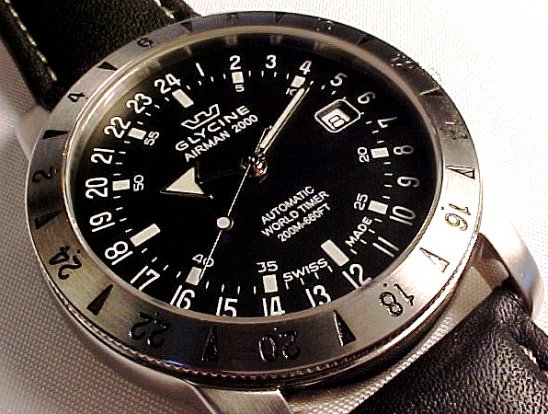


The Glycine watch company was founded in 1914 in Bienne, Switzerland. In 1934, Glycine introduced its first line of watches to pass the difficult tests of the Official Swiss Quality Control and earn chronometer certificates. Glycine is one of the few companies to exhibit at the 1938 Basel Fair. Glycine's production has continued without interruption since its founding. Glycine introduced the now famous Airman in 1953. The model reviewed here features a 24 hour display, as did the original. Designed specifically for pilots, the Airman is considered by many to be a quintessential aviation watch.
1. The, Bezel, Crystal, Dial and Hands.
This Glycine Airman has a bi-directional rotating bezel engraved with 24 hour markings finished in black for easy reading. The bezel itself is stainless steel with brushed finish for low reflectivity and a coin edge for improved grip. The bezel's rotating mechanism offers a nice amount of resistance and a precise feel.
The crystal is synthetic sapphire. It is flat, beveled at the edge and set slightly above the bezel. The crystal does not appear to have an anti-reflective coating, yet I find the watch easy to read in all light.
This Airman has a deep matte black dial that is extremely legible. The hours are marked numerically and with luminous squares of tritium. The printing on the dial is crisp and the tritium is well applied.
The oversized arrow-shaped hour hand is reminiscent of pilot's watches of days past, as is the bubble style second hand. Tritium has also been applied to the hands, and this dial-hands combination glows brightly at night. As noted above, this watch has a 24 hour display, with the hour hand making a single revolution once per day. The minute and second hands move in standard fashion. This type of display has always interested me. It seems eminently practical. When I don't wear my standard 12 hour display watches for a few days and they run down, I'm never sure if they quit in the a.m. or the p.m. There's no guessing with this Airman. The 24 hour display does take a bit of getting used to. This is the first non-12 hour display watch I've worn, and I find that when I look at the watch, determining the time requires a quick mental calculation. This reflects my habit of telling time by the position of the hands, not the numbers on the dial.






2. The Case and Strap.
This Airman has a stainless steel case and calf leather strap. The case is lightly brushed on the top and highly polished on the sides and back, including between the lugs. The case is well finished with no sharp edges. The watch is 40 mm in diameter measuring across the bezel, not including the crown, and 10 mm thick. This watch requires a 22 mm strap. The lugs curve down slightly to give the watch a nice fit on the wrist. This watch has a stainless steel screw down back and crown, and it is rated at 200 meters/660 feet. The Airman 2000 is also available with a mineral glass back. The calf strap is very soft and comfortable. The strap is treated at the factory and is highly water resistant. Despite the size of this watch, I find it very comfortable to wear.






3. The Movement.
This Airman uses the ETA 2893 movement. This movement is automatic winding with 21 jewels, tuned to 28,800 bph. The seconds hack or stop when the crown is in the time setting position, allowing easy synchronization with another time reference. The movement is undecorated except for the brushed finish and engraving on the rotor. The plates and bridges are polished, as are the screw heads and exposed steel components. The balance wheel has three spokes and incorporates Incabloc shock protection. This is a basic-dress ETA movement with a good reputation for reliability.
This Airman is a fairly accurate timekeeper. I compared it with my atomic clock for the first 48 hours out of the box, and it ran at + 8 seconds per day, being stored dial up at night. Better performance might be achieved experimenting with storage positions when the watch is not in use. Though not always true, the horizontal dial up position is often the "fastest" position, and storing a watch in this position, which is common, can cause the watch to gain a few seconds.


4. Overall Impressions.
This Glycine Airman 2000 offers good looks and legibility, a well finished case with sapphire crystal, a comfortable strap, two time zone capability and a distinctive and practical 24 hour display. The Airman has a strong reputation among pilots, both military and civilian. At 40 mm, the watch has a strong presence on the wrist, yet it is not uncomfortably large or heavy. On the whole, I like this Airman.
5. Summary and Contact Information.
Watch reviewed: Glycine Airman 2000, ref. 3764.18T-66. Stainless steel case, leather strap with stainless steel buckle. Screw down back and crown, bi-directional rotating bezel and sapphire crystal. Matte black dial. Hour, minute and center second hand, second time via rotating bezel, quick correcting date at 3.
Movement: ETA 2893, 21 jewels, 28,800 alterations per hour.
Water resistance rating: 20 ATM / 200 meters / 660 feet.
Suggested USA retail price as of the date of this review: $844.
Contact information: Website: www.glycine-watch.ch
E-mail: glycine@glycine-watch.ch

Back to top of page | Return to Time Zone Home Page
Copyright © 2001-2004 A Bid Of Time, Inc., All Rights Reserved
E-mail: info@TimeZone.com